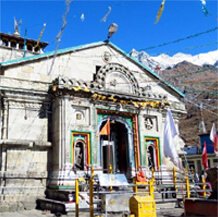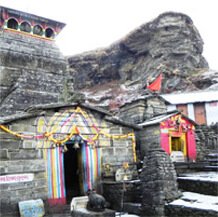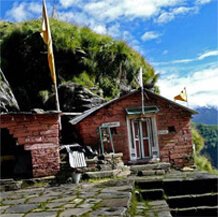
Places in Panch Kedar Yatra
Legends have a way of getting twirled or divided into many streams
while they go down the time line through centuries. One of the versions
of the most popular legend associated with the formation of Panch Kedar
relates to the era of Mahabharata. After killing their blood relatives
and gurus, the enormous load of remorse made the Pandavas seek Lord
Shiva for atonement.
Enraged with their actions and dishonesty on the war field, Lord Shiva evaded their requests. He hid at Guptkashi in the Himalayas of Garhwal disguised as a bull. Pandavas came looking for Shiva in the Garhwal region and recognized God Shiva in the form of bull. Bhim tried to catch hold of the bull but it dived in the ground and vanished.
Enraged with their actions and dishonesty on the war field, Lord Shiva evaded their requests. He hid at Guptkashi in the Himalayas of Garhwal disguised as a bull. Pandavas came looking for Shiva in the Garhwal region and recognized God Shiva in the form of bull. Bhim tried to catch hold of the bull but it dived in the ground and vanished.
That is why, it is believed, the site of Guptkashi (hidden kashi) got its name.
Shiva reappeared in parts at different parts of Garhwal. Hump came up at Kedarnath, navel appeared at Madhya-Maheshwar, face emerged at Rudranath, arms at Tungnath and hair at Kalpeshwar.
Pandavas built temples at each of the five places where the Lord emerged as such. Taken together these five places came to be known as Panch Kedar.
Given below are the five most important homes of Lord Shiva in Garhwal Himalayas in the sequence in which they should be visited:
Shiva reappeared in parts at different parts of Garhwal. Hump came up at Kedarnath, navel appeared at Madhya-Maheshwar, face emerged at Rudranath, arms at Tungnath and hair at Kalpeshwar.
Pandavas built temples at each of the five places where the Lord emerged as such. Taken together these five places came to be known as Panch Kedar.
Given below are the five most important homes of Lord Shiva in Garhwal Himalayas in the sequence in which they should be visited:
1.Kedarnath
 Located at a height of 3,584 metres, Kedarnath temple is set in a
spectacular background of snow-clad peaks and forests. It is in
Rudraprayag district of Uttarakhand and occupies a prominent position
among the Panch Kedar temples. The temple houses a conical shaped Shiva
lingam which is considered to be the hump of Shiva. Present temple,
built with grey stone slaps, is said to be established by Adi
Shankaracharya in 8/9th century A.D. Nearest motorable road towards
Kedarnath is Gaurikund. After which a trekked path of 14 km is taken to
reach the shrine. The trek, though mainly steep, takes one through
wonderful landscapes, keeping the spirits of pilgrims soaring at all
times.
Located at a height of 3,584 metres, Kedarnath temple is set in a
spectacular background of snow-clad peaks and forests. It is in
Rudraprayag district of Uttarakhand and occupies a prominent position
among the Panch Kedar temples. The temple houses a conical shaped Shiva
lingam which is considered to be the hump of Shiva. Present temple,
built with grey stone slaps, is said to be established by Adi
Shankaracharya in 8/9th century A.D. Nearest motorable road towards
Kedarnath is Gaurikund. After which a trekked path of 14 km is taken to
reach the shrine. The trek, though mainly steep, takes one through
wonderful landscapes, keeping the spirits of pilgrims soaring at all
times.2.Tungnath
 At a height of 3,680 meters lies the highest temple of Shiva in the
world. In the Rudraprayag district of Uttarakhand, Tungnath can be
reached by indulging in 4 km (approx.) trek from Chopta. It is here that
Shiva's arms have said to appear. A moderate trek, walking on the paved
path towards Tungnath will provide vistas of splendid peaks such as
Nanda Devi, Kedarnath, Chowkhamba and Neelkanth. Lovely meadows and
delightful flowers of rhododendron will greet you at regular intervals.
One can further trek up to 2 km to Chandrashila peak to see an
incredible panoramic view of the surrounding peaks.
At a height of 3,680 meters lies the highest temple of Shiva in the
world. In the Rudraprayag district of Uttarakhand, Tungnath can be
reached by indulging in 4 km (approx.) trek from Chopta. It is here that
Shiva's arms have said to appear. A moderate trek, walking on the paved
path towards Tungnath will provide vistas of splendid peaks such as
Nanda Devi, Kedarnath, Chowkhamba and Neelkanth. Lovely meadows and
delightful flowers of rhododendron will greet you at regular intervals.
One can further trek up to 2 km to Chandrashila peak to see an
incredible panoramic view of the surrounding peaks.3.Rudranath
 It is the place where Shiva's face came up the ground. A natural rock
temple, situated at the height of 2,286 meters amid alpine meadows and
thick forests of rhododendrons, is where Shiva is worshipped as
'Neelkanth Mahadev'. Many sacred kunds (pools) such as Surya Kund,
Chandra Kund, Tara Kund and Mana Kund exists around the temple. Fabulous
peaks of Nanda Devi, Nanda Ghunti and Trishul form an amazing backdrop.
The trek involved is considered harder to reach as compared to other
Panch Kedar temples. Most of the treks leading to Rudranath start from
various points in Gopeshwar (in Chamoli district) and can stretch up to
20 km.
It is the place where Shiva's face came up the ground. A natural rock
temple, situated at the height of 2,286 meters amid alpine meadows and
thick forests of rhododendrons, is where Shiva is worshipped as
'Neelkanth Mahadev'. Many sacred kunds (pools) such as Surya Kund,
Chandra Kund, Tara Kund and Mana Kund exists around the temple. Fabulous
peaks of Nanda Devi, Nanda Ghunti and Trishul form an amazing backdrop.
The trek involved is considered harder to reach as compared to other
Panch Kedar temples. Most of the treks leading to Rudranath start from
various points in Gopeshwar (in Chamoli district) and can stretch up to
20 km.4.Madhyamaheswar
 At the height of about 3,289 meters, Madhyamaheswar is the place
where, it is believed, the middle or navel part of Shiva emerged. The
temple lies in a beautiful green valley in the Mansoona village of
Garhwal Himalayas and is encircled by spectacular snow-covered peaks of
Kedarnath, Chaukhamba and Neelkantha. Trek to Madhyamaheswar can be
undertaken from Uniana, which is around 18 km from Ukhimath. The trek is
19 km (approx.) long and can be easily travelled till Bantoli (some 10
km from Uniana); from Bantoli the slope becomes steeper and a little
difficult.
At the height of about 3,289 meters, Madhyamaheswar is the place
where, it is believed, the middle or navel part of Shiva emerged. The
temple lies in a beautiful green valley in the Mansoona village of
Garhwal Himalayas and is encircled by spectacular snow-covered peaks of
Kedarnath, Chaukhamba and Neelkantha. Trek to Madhyamaheswar can be
undertaken from Uniana, which is around 18 km from Ukhimath. The trek is
19 km (approx.) long and can be easily travelled till Bantoli (some 10
km from Uniana); from Bantoli the slope becomes steeper and a little
difficult.
Bantoli is also the place where Madhyamaheswar Ganga merges with Martyenda Ganga. The verdant forest; the beautiful wildlife, including the endangered Himalayan monal pheasant and Himalayan musk deer; waterfalls; and surrounding peaks makes this trek a truly memorable one.5.Kalpeshwar
 In the Kalpeshwar temple, Lord Shiva's hairs (jatas) appeared, as per
the legend. Because of the long and tangled locks of Shiva, he is also
called Jatadhari or Jateshwar. The temple of Kalpeshwar is located in
the tranquil and scenic Urgam valley in Chamoli district of Uttarakhand,
at an elevation of 2,200 metres. Urgam valley, mainly covered in dense
forest, proffers interesting vistas of apple orchards and potato
plantations on terraced fields.
In the Kalpeshwar temple, Lord Shiva's hairs (jatas) appeared, as per
the legend. Because of the long and tangled locks of Shiva, he is also
called Jatadhari or Jateshwar. The temple of Kalpeshwar is located in
the tranquil and scenic Urgam valley in Chamoli district of Uttarakhand,
at an elevation of 2,200 metres. Urgam valley, mainly covered in dense
forest, proffers interesting vistas of apple orchards and potato
plantations on terraced fields.
Helang, located on Rishikesh-Badrinath road, is the place from where one can reach Urgam valley. From Urgam there is an easy trek of 2 km till Kalpeshwar. On the trip from Helang to Kalpeshwar one can witness the beautiful confluence of Alaknanda and Kalpganga Rivers. Being placed as such, one can easily club the two destinations - Kalpeshwar and Badrinath - in one's religious itinerary.












